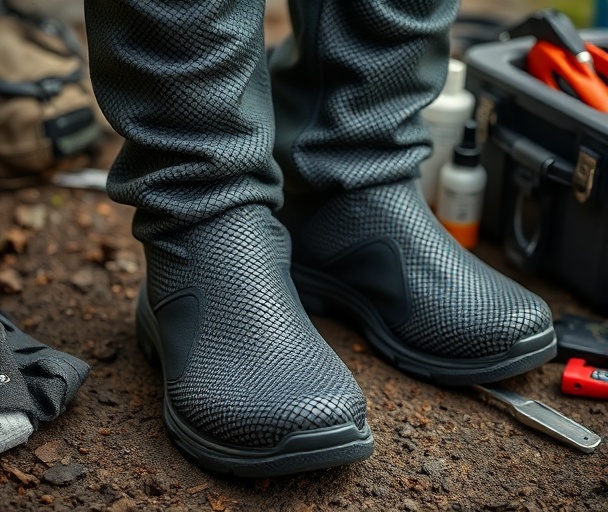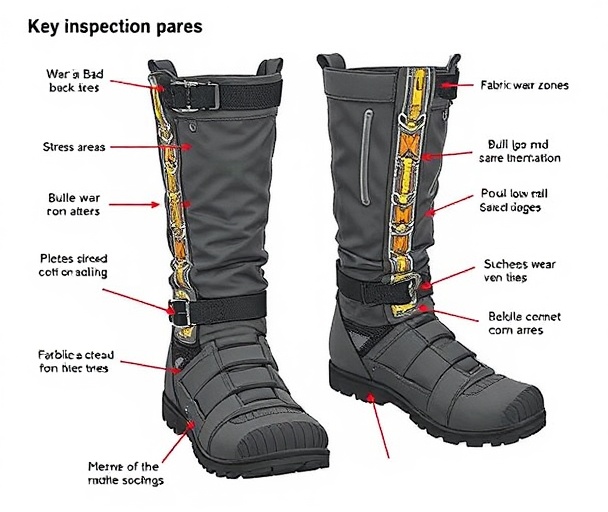Snake Gaiter Care & Maintenance
Keep your gaiters reliable with proper cleaning and storage practices
Why Proper Care Matters
Snake gaiters are your first line of defense against venomous bites, making proper care essential for maintaining their protective capabilities. Regular maintenance not only extends the life of your investment but ensures reliable protection when you need it most.
Well-maintained gaiters provide consistent bite resistance, waterproof protection, and comfort throughout their lifespan. Neglected equipment can fail at critical moments, compromising your safety and requiring costly premature replacement. Understanding the different materials used in snake gaiters is crucial for proper care techniques.
Maximum Safety
Maintained materials retain full bite protection capabilities
Extended Durability
Proper care can double your gaiters' usable lifespan
Cost Savings
Avoid premature replacement with simple maintenance

Cleaning Snake Gaiters
Proper cleaning techniques vary by material type and contamination level. Follow these expert methods to maintain protection without damaging your gaiters. The cleaning approach depends heavily on your gaiter's construction materials.
Cleaning Methods
Spot Cleaning
For light dirt, mud, or localized stains - especially important after hiking adventures:
- •Use damp cloth with mild soap solution
- •Gently scrub affected areas only
- •Rinse with clean water and pat dry
- •Ideal for quick maintenance after each use
Full Washing
For heavy soiling or periodic deep cleaning - particularly needed after hunting in muddy conditions:
- •Remove PP panels if detachable
- •Machine wash cold, gentle cycle
- •Use mild, non-detergent soap
- •Never use bleach or fabric softeners
Material-Specific Care
Oxford Fabric (600D/900D)
Heavy DutyMost durable, handles aggressive cleaning - learn more about Oxford fabric properties:
- • Scrub brush for stubborn stains
- • Machine washable with regular cycle
- • Can handle warm (not hot) water
Nylon & Polyester
Gentle CareLightweight materials need careful handling - common in budget-friendly options:
- • Cold water only to prevent shrinkage
- • Gentle cycle or hand wash preferred
- • Avoid abrasive scrubbing
PP Panels
Hand CleanRigid panels require special attention - found in professional models like those in our GEARO-Z review:
- • Remove and clean separately
- • Wipe with disinfectant solution
- • Never machine wash or bend
Leather/Canvas
TraditionalClassic materials need traditional care - still popular for ranch work:
- • Hand clean with leather conditioner
- • Never fully submerge in water
- • Oil treatment for flexibility
Pro Cleaning Tips
Pre-Treatment
- • Remove excess dirt before washing
- • Pre-treat blood stains with cold water
- • Open all straps and buckles
Cleaning Frequency
- • After every muddy/dusty use
- • Monthly with regular use
- • Immediately after contamination
For more maintenance guidance, check our complete protective gear care guide.
Drying & Waterproofing
Proper drying prevents material damage and mold growth, while regular waterproof treatment maintains weather protection. This is especially critical for waterproof gaiter models.
Proper Drying Methods
Air Drying Only
The only safe method for all gaiter materials - critical for maintaining the integrity of advanced synthetic materials:
- ✓Hang in well-ventilated area
- ✓Avoid direct sunlight (causes UV damage)
- ✓Turn inside-out halfway through
- ✓Ensure complete drying (24-48 hours)
Never Use Heat
High heat damages protective materials - this can void warranties on quality gaiters like our reviewed Frelaxy models:
- ✗Machine dryer (even low heat)
- ✗Hair dryer or heat gun
- ✗Radiator or heating vents
- ✗Direct sunlight for extended periods
Waterproof Treatment
When to Reapply DWR
Maintaining waterproof coatings is essential - learn more about waterproof technology maintenance:
Application Process
Clean Thoroughly
Ensure gaiters are completely clean and dry
Apply Evenly
Spray DWR treatment from 6 inches away
Heat Activate
Use hair dryer on low heat to activate coating
Test Protection
Sprinkle water to verify beading effect
Recommended Treatments
- • Nikwax TX.Direct (spray-on)
- • Granger's Performance Repel
- • ReviveX Durable Water Repellent
- • Scotchgard Heavy Duty Water Shield
For weather protection tips, see our weather awareness guide.
Storage Best Practices
Proper storage prevents damage, maintains material integrity, and ensures your gaiters are ready for use when needed.
Environment
Ideal Conditions
- •Cool, dry location (60-75°F)
- •Low humidity (<50%)
- •Good air circulation
- •Away from direct sunlight
Avoid These Areas
- ×Attics or basements
- ×Car trunks or garages
- ×Near heat sources
- ×Damp or humid areas
Folding Methods
Fabric Gaiters
- •Fold along natural seam lines
- •Avoid sharp creases
- •Roll loosely if space allows
- •Place tissue paper between layers
PP Panel Gaiters
- !Never fold rigid panels
- •Store flat when possible
- •Use original carrying case
- •Gentle curve only if needed
Containers
Best Options
- •Breathable fabric storage bags
- •Original manufacturer case
- •Cedar-lined gear closet
- •Mesh laundry bags
Avoid
- ×Plastic bags (trap moisture)
- ×Airtight containers
- ×Cardboard boxes
- ×Direct floor contact
Pre-Storage Checklist
Essential Steps
Long-term Storage
Inspection & Repairs
Regular inspection identifies wear patterns and potential failures before they compromise your safety. Learn when to repair and when to replace. This is crucial for maintaining the protection standards outlined in our complete buying guide.
Inspection Schedule
Before Each Use
Essential pre-activity checks - especially important before hiking expeditions or hunting trips:
- •Quick visual inspection for obvious damage
- •Test all buckles and adjustments
- •Check strap security and wear
Monthly Deep Inspection
Thorough examination of all components - follow our sizing guide to ensure proper fit during inspection:
- •Examine seams for thread degradation
- •Check fabric for punctures or thin spots
- •Test waterproof coating effectiveness
- •Inspect hardware for corrosion
Annual Professional Check
- •Comprehensive material integrity assessment
- •Bite protection capability evaluation
- •Professional repair recommendations
Key Inspection Points

High-Stress Areas
- • Ankle and calf strap attachment points
- • Bottom seam where boot contact occurs
- • Buckle mounting areas
- • Instep strap connection
Protection Zones
Critical for models like those in our detailed reviews:
- • Front and side panel integrity
- • PP panel security and condition
- • Seam strength around protective areas
- • Fabric thickness consistency
Hardware Components
- • Buckle operation and alignment
- • Velcro hook and loop effectiveness
- • Elastic band tension and stretch
- • D-ring and hardware corrosion
Repair vs. Replace Decision Guide
Use this guide to determine when repairs are safe versus when replacement is necessary. For replacement options, check our comprehensive buying guide.
Repairable Issues
- ✓Worn buckles or broken hardware
- ✓Loose stitching in non-critical areas
- ✓Worn Velcro strips
- ✓Minor scuffs or surface wear
- ✓Degraded waterproof coating
- ✓Stretched elastic components
Replace Immediately
- ⚠Punctures or tears in protection zones
- ⚠Delaminated PP panels
- ⚠Significant fabric thinning
- ⚠Failed seams in critical areas
- ⚠Cracked or broken PP panels
- ⚠Multiple repair points
Safety Rule: When in doubt about protection integrity, always replace rather than risk your safety. Consider our budget-friendly options for cost-effective replacements.
Common Mistakes to Avoid
Learn from these frequent care mistakes that can damage your gaiters, reduce their effectiveness, or shorten their lifespan. These issues affect both budget models and premium options.
Storage Mistakes
Storing Dirty Gaiters
Putting away dirty or damp gaiters leads to mold, odors, and material degradation. This is especially problematic after muddy hunting trips.
Plastic Bag Storage
Plastic bags trap moisture, creating perfect conditions for mold and mildew growth. This ruins even high-quality waterproof gaiters.
Extreme Temperature Storage
Hot attics, cold garages, and car trunks cause material expansion/contraction damage - particularly harmful to the synthetic materials used in modern gaiters.
Crushing PP Panels
Folding or compressing rigid panels can crack them, eliminating protection. This affects professional models like those in our GEARO-Z review.
Cleaning Mistakes
Using Harsh Chemicals
Bleach, strong detergents, or solvents break down protective coatings and fibers. This can destroy the waterproof treatments on quality models.
Machine Drying
High heat damages synthetic materials, melts coatings, and can warp PP panels. This can void warranties on quality gaiters like our reviewed Frelaxy models.
Ignoring Strap Wear
Worn straps can fail suddenly, leaving you without protection when needed most. Check our sizing guide for proper strap adjustment.
Delaying Waterproof Treatment
Waiting until gaiters are already soaking through leaves you vulnerable to moisture. Learn more about waterproof maintenance.
Critical Warning Signs
If you notice any of these signs, stop using your gaiters immediately and assess for replacement. Consider our buying guide for replacement options.
Material Failure
- • Visible punctures or tears
- • Fabric becoming transparent
- • Delaminated coatings peeling
- • Cracked PP panels
Hardware Issues
- • Buckles won't secure properly
- • Straps are fraying badly
- • Velcro has lost adhesion
- • Metal parts show corrosion
Age & Usage
- • More than 5-8 years old
- • Heavy daily use for 2+ years
- • Multiple previous repairs
- • Manufacturer discontinuation
Remember: Your life depends on these gaiters working properly. When safety is uncertain, replacement is always the safer choice. Check our snake encounter prevention guide for additional safety tips.
Keep Your Protection Reliable
Proper care extends your gaiters' life while maintaining the protection you depend on. Regular maintenance is a small investment that pays huge dividends in safety and durability.
Safety First
Well-maintained gaiters provide reliable protection when you need it most. Never compromise on safety.
Extended Life
Simple maintenance routines can double your gaiters' usable lifespan and performance.
Cost Effective
Regular care prevents expensive premature replacement and maintains your investment.
Essential Care Checklist
Regular Maintenance
Regular Inspection
Continue Learning
Need New Snake Gaiters?
If your inspection reveals it's time for replacement, check our expert reviews and buying guides to find the perfect new gaiters.